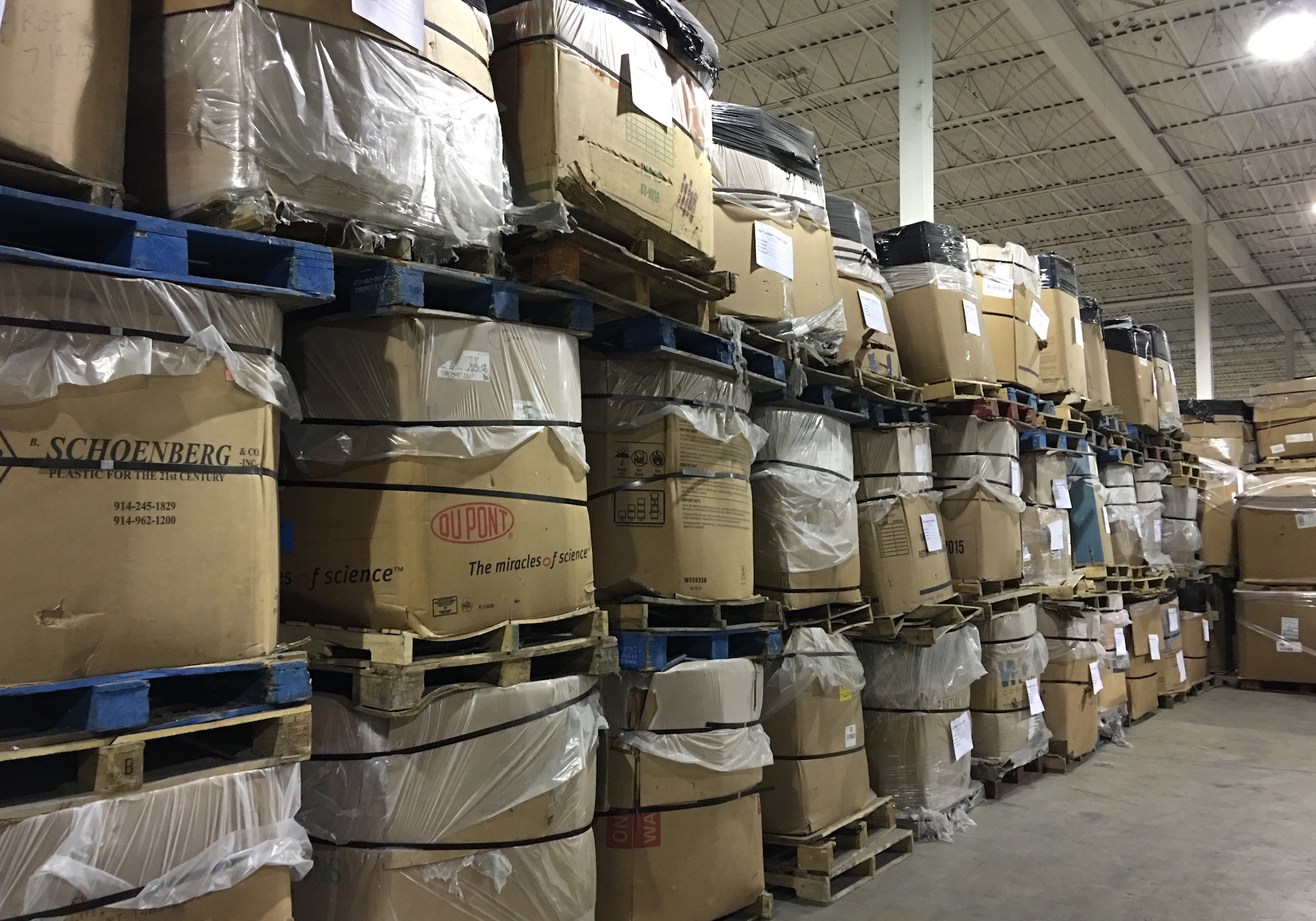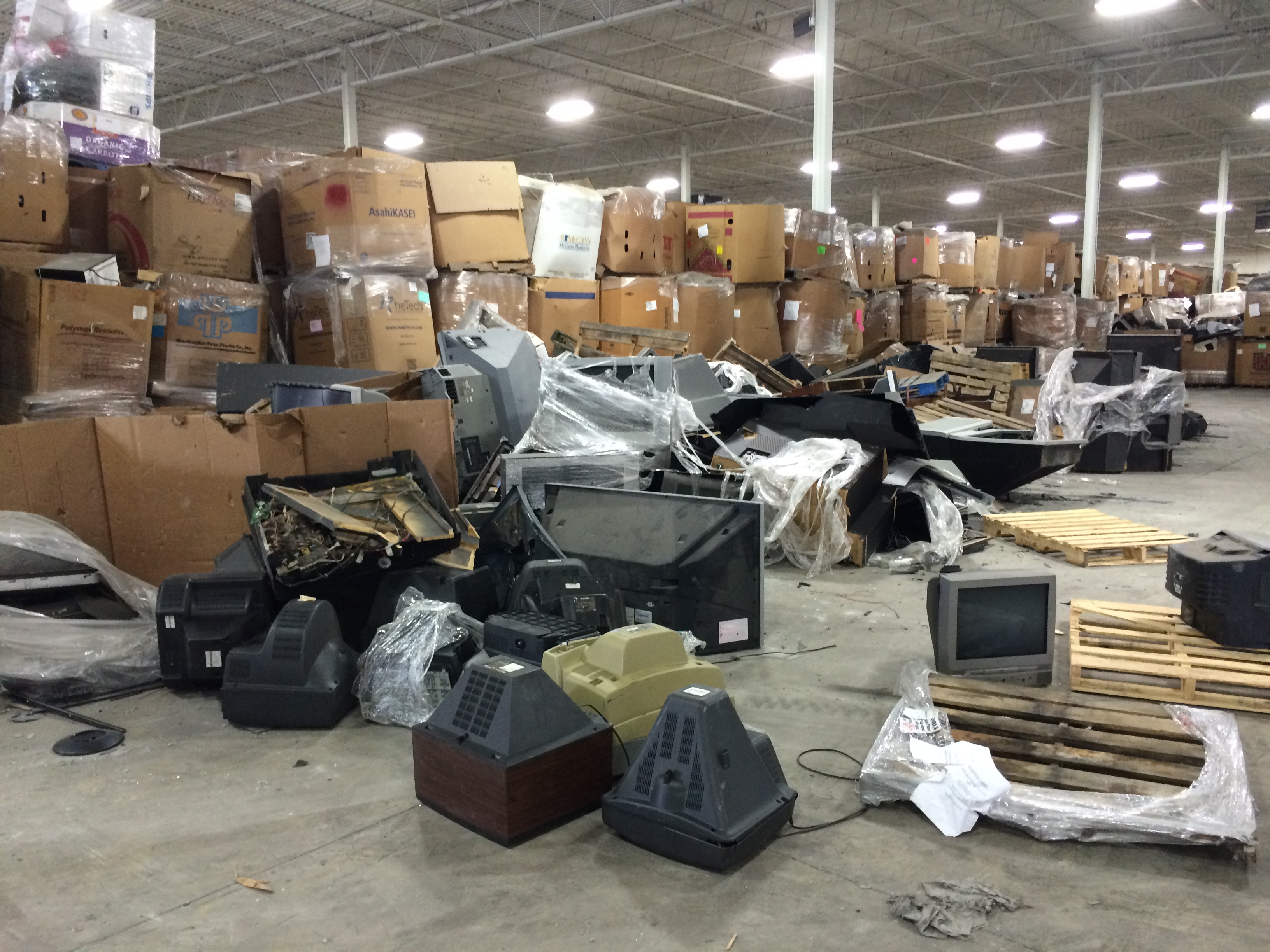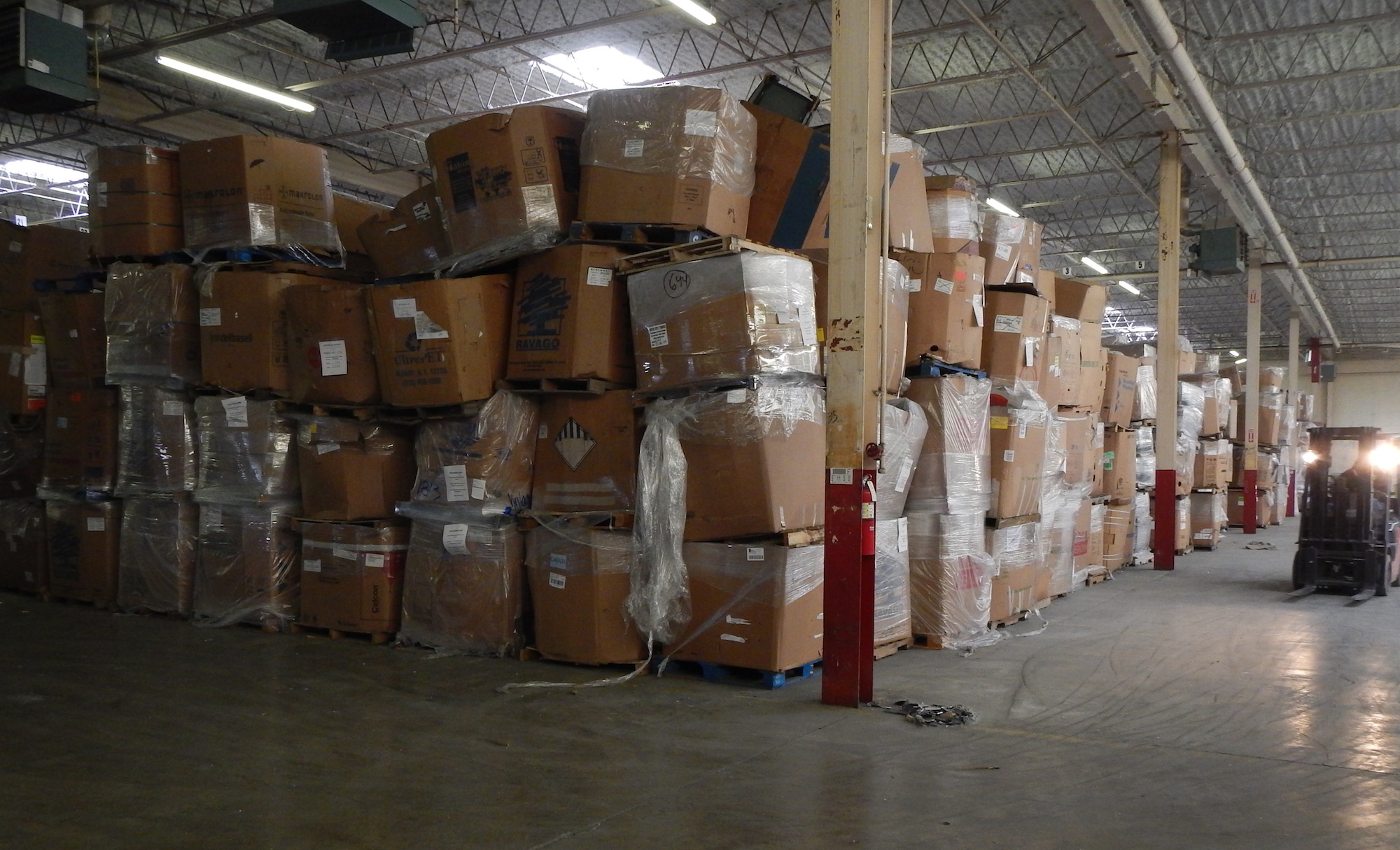A version of this story appeared in the February issue of VICE magazine. Click HERE to subscribe.
Over the blaring din of forklifts overturning dumpsters full of servers, circuit boards, and miscellaneous computer parts, I watched men hit antiquated, boxy televisions with hammers.
“If you don’t hit the yoke in the right way,” Eric Mims, operations manager of the ECS Refining electronics-recycling center in a suburb of Dallas, told me, pointing at his workers, who are clad head-to-toe in blue jumpsuits, respirators, earplugs, plastic safety goggles, and thick work gloves, “it can explode.”
Years after most Americans switched to flat-screens, we’re just now beginning to deal with the long-term ramifications of sustainably disposing of old cathode-ray televisions and computer monitors. This dangerous, labor-intensive, and costly undertaking will have to be done for each of the estimated 705 million CRT TVs sold in the United States since 1980. CRT processing, as it’s called, happens at only a handful of the best e-waste recycling centers in the United States. In many cases, your old TV isn’t recycled at all and is instead abandoned in a warehouse somewhere, left for society to deal with sometime in the future.
Videos by VICE

This image and the image at the top of this article show ECS Refining’s processing facility in a suburb of Dallas, Texas. ECS Refining is one of the few recycling centers in the United States that properly deal with CRT glass. Image: Cooper Neill for VICE Magazine/Motherboard
At ECS, televisions affixed with Post-it Notes labeling each unit’s weight have been arranged in a line, ready to be hammered, crowbarred, and sawed back into their component parts. There are old Sony Trinitrons, wood-paneled RCAs, and huge plastic Toshibas. Plastic TVs weigh up to 80 pounds, but larger, rear-projection CRTs can weigh as much as 500 pounds, and surely, in better days, had prominent spots in family rooms around the country.
Demanufacturing the televisions is hard manual labor that works as a reverse assembly line, as the components from these old TVs are separated by hand and moved down a conveyor belt. First, they use a crowbar to remove the back case. They cut, strip, and sort the power cords. They remove internal screws with drills. What’s left of the TV is then hammered, to separate the front screen from the cathode-ray vacuum tube. They strip the wires for copper. Wood will eventually be composted or turned into sawdust. Plastic is put through a shredder so that it can be melted. A handheld grinder spews sparks as it separates the screen from whatever is left of the tube. Then, more smashing—this time, the glass.
They run the glass through an ultraviolet-light chamber on a conveyor belt to determine whether it contains lead. This lead content—about four pounds per television, and difficult to separate from the glass itself—has caused an ongoing economic and environmental problem for the nation’s electronics recyclers.
Closed Loop took taxpayer money to not recycle your old TV
CRTs cost more to recycle than the commodities inside them can be sold for, meaning that old TVs have a net negative recycling value. And new guidelines for the amount of lead exposure that is safe for humans have cut down on the total number of possible uses for leaded glass (ECS’s workers have their blood tested for lead content quarterly).
Maybe you took your old TV to a community e-waste collections center after you upgraded to a flat-screen. If the collection center was responsible, maybe it sent that television to ECS. If it wasn’t, maybe that TV eventually ended up at Closed Loop.
***

Inspection image of one of Closed Loop’s Columbus warehouses, taken by the Ohio Environmental Protection Agency.
The business plan for Closed Loop Refining and Recycling was simple: The company was going to be a one-stop shop for CRT recycling in the United States, a dream that has remained elusive since the last US factories making CRTs with recycled glass shut down. Founded in 2010 by recycling industry veterans David Cauchi and Brent Benham, Closed Loop’s strategy was to build a furnace that could melt the lead out of CRT glass, creating two separate commodities that could be sold for a profit.
The company’s landlords have been told that it will cost tens of million dollars to safely dispose of the glass
Closed Loop began accumulating CRTs from all over the country in hopes of one day feeding them to its furnace. It served as a downstream recycler, meaning that, for a fee, it took TVs and computer monitors from other recycling companies that collected but didn’t have the specialization to process CRTs. For years, daily truckloads of CRTs arrived at Closed Loop’s facilities in Columbus, Ohio, and Phoenix, Arizona. The company recycled only a fraction of a percent of the televisions it collected.

An Ohio EPA letter to Closed Loop sent in April 2016 declared that the company could no longer be considered to be “recycling.” Document acquired using Ohio Freedom of Information Act.
Today, Closed Loop’s facilities are the nation’s two largest television graveyards, an environmental and economic disaster with no clear solution. There are at least 25,000 tons of glass and unprocessed CRTs in Arizona, and much of it is sitting in a mountainous pile outside one of the warehouses. The Ohio facility is considerably larger, with several former employees and auditors I’ve spoken to suggesting there could be as much as 100,000 tons of potentially hazardous waste stored in two warehouses there. The company’s landlords have been told that it will cost tens of million dollars to safely dispose of the glass that’s been stockpiled there.

One of Closed Loop’s Ohio facilities. Image: Ohio EPA
“We saw a lot of things that made us nervous,” said Kelley Keogh, co-founder of Greeneye Partners, a California-based company that audited Closed Loop several times a year to determine for its clients if the company was actually recycling the glass that it was sent. “For me, it was obvious that what they were doing looked like a risk. For the most part, my clients did not send glass there.”
If you work in the e-waste industry or worked at Closed Loop and have anything to share about how it works, you can contact me securely here.
Keogh says that Closed Loop was amassing huge numbers of CRTs with only a token amount of outbound shipping—CRTs that were coming in sat in warehouses rather than being recycled. Meanwhile, there was no evidence that Closed Loop was making any progress at all on the furnace. In November 2013, the company got permission from the Ohio Environmental Protection Agency (EPA) to build its furnace, but a state inspection in December 2014 found that “no work had commenced on the vacant half of the warehouse where [the furnace] is supposed to conduct operations.”

Image: Environmental Protection Agency
There were other signs that things were not going well at Closed Loop. The company stopped paying rent for its Ohio facility in June 2014, and it repeatedly told the Ohio EPA auditors that the few CRT-processing machines it did have were broken. In March 2015, rumors swirled that the company was going to have difficulty making payroll. Government and independent auditors eventually learned that the company had rented additional storage facilities that it wasn’t forthcoming with inspectors about. An employee at the Ohio EPA speculated in internal inspection documents that the company might have been shipping glass back-and-forth between the warehouses to avoid a regulation that prevents recyclers from holding CRT glass for more than one year. The documents were acquired using the Ohio Freedom of Information Act and were shared with Motherboard.
Lawyers for Closed Loop’s landlords would not allow me to access any of the company’s warehouses in either Arizona or Ohio, citing the potentially hazardous nature of entering the facilities. The photos of Closed Loop’s facilities in this article were taken by Ohio EPA inspectors and were obtained by Motherboard using an Ohio Freedom of Information Act requests. The Arizona Department of Environmental Quality did not respond to a request under that state’s freedom of information law.
Keogh says the State of California, which requires recyclers in the state to submit information about where it ships its waste downstream, suggested her company check additional warehouses in Phoenix that belonged to Closed Loop but weren’t listed as any of the company’s main warehouses.

Image: Ohio EPA
“Closed Loop did allow us access to the other buildings, but the glass in those buildings had dates that showed they were there for over two years. It was hard to know if they had been sitting there or had been moved from one warehouse to another,” she said. “One of the buildings did have a lockbox and a note from the landlord, which suggested to me they were behind on rent, but Closed Loop still had access to the building. Whatever that meant, those were red flags.”
***
Closed Loop’s brewing disaster was the worst-kept secret in the recycling industry. I attended the Electronics Reuse Conference in Houston last fall, and the talk of the show was how Closed Loop’s slow-moving march toward insolvency had finally blown up in the industry’s face.
The company’s demise was not an anomaly. Though it is the largest CRT processor in the US to go under, the industry has been increasingly struggling with what to do about CRT glass, and so, in many cases, recyclers end up doing nothing. Creative Recycling left 15,000 tons of CRT glass in six facilities in South Carolina, and the EPA has found warehouses full of abandoned glass in Arizona, Ohio, Colorado, Pennsylvania, New York, Utah, Massachusetts, and Kentucky in the past three years alone.
Most in the industry don’t believe that Closed Loop intended to rip off its clients. Former employees and auditors say that Closed Loop went through far more effort than was necessary to run a simple scam.

Image: Ohio EPA
“There are a lot easier ways to make money,” John Lingelbach, executive director of SERI, the group that manages the R2 Recycling certification for electronics recycling, told me. “Many of these people who find themselves in these challenging situations initially get into it innocently and get in over their heads at some point and don’t know when to stop.”
Not knowing when to call it quits is a problem that almost certainly happened at Closed Loop. Last year, co-founder Brent Benham told the trade publication E-Scrap News that a $16 million loan—part of which would have been used to build the furnace—fell through, but the company has never said how it spent all the money it made from taking in CRTs.

An Environmental Protection Agency presentation shows that abandoned CRT warehouses are common. Image: EPA
Closed Loop announced it would be shutting down in May 2016, but as late as March of that year, the Ohio EPA found that the company was still “bringing in approximately two truckloads a day of CRTs” from upstream recyclers, according to an inspection report by the agency’s hazardous-waste expert Andy Maneff. Closed Loop did eventually begin sending a small amount of its glass—about 1.4 million pounds—to overseas CRT recyclers, which is a half percent of the estimated total amount of glass it took in.
Millions of televisions at Closed Loop and other warehouses around the country still must be safely disposed of, somehow
That companies were still willingly paying Closed Loop to take their unwanted CRTs speaks to the desperation many recyclers have to wash their hands of the responsibility of recycling them. The situation is further complicated because many of Closed Loop’s customers were companies that participated in state-run recycling programs, meaning Closed Loop took taxpayer money to not recycle your old TV.

The Ohio EPA wrote in inspection documents that Closed Loop did not properly handle hazardous material. Image: Ohio EPA
“Some of the glass from Creative [Recycling] went to a company in Kentucky called Global Environmental Services, then ended up at Closed Loop. Now someone has to take it from there,” Keogh said. “By the time it’s all done, it will have been paid for four times, which is pretty cool for a commodity that has no frickin’ value.”
Everyone I spoke to came to the same conclusion. Whether Cauchi and Benham (the two declined through their lawyer to talk to me for this story) intended to rip people off is irrelevant, because the result is the same either way: Millions of televisions at Closed Loop and other warehouses around the country still must be safely disposed of, somehow.
The situation has gotten so bad that, rather than recycle CRTs, many companies have started sending their glass to a company called Kuusakoski Recycling, which is using treated leaded glass as a daily landfill cover in Peoria, Illinois. Critics say that literally burying the CRT problem in hopes that subsequent technologies such as laptops, smartphones, and fitness trackers will be more profitable and less hazardous to recycle is no solution at all, and the EPA has determined that Kuusakoski’s process, called KleanKover, is not technically recycling.
***

Image: Ohio EPA
The CRT mess, the industry says, has been caused by a fundamental refusal by society to acknowledge that recycling is an expensive proposition. For years, electronics recyclers have made money by melting commodities—mostly gold, silver, and copper—from our old things. Most companies used the money earned from recycling servers, computers, cameras, and video game consoles to offset the recycling of CRT monitors and televisions, which were never very profitable but have always made up a large percentage of the total weight of electronics recycling.
But stricter health standards and the end of new CRT manufacturing have reduced demand for leaded glass. Falling commodity prices have made it difficult to subsidize CRT recycling, and companies like Closed Loop keep prices artificially low by speculating that one day new technologies could make CRT recycling profitable. Then there are scam companies that drive prices even lower by taking old televisions for impossibly low rates with no intention of recycling them.
“It’s been a vicious circle in the wrong direction, and it hasn’t been a major concern for people upstream, who are happy to go with the lowest-price provider,” Jim Taggart, the CEO of ECS Refining, told me. “Recycling this is a bigger and more complex task than any of these companies anticipate.”
What should scare us is that newer electronics are more difficult to recycle than CRTs, not easier
If there is a silver lining here, it’s that leaded glass can be recycled if you’re willing to pay for it. Many recyclers in the US send their processed CRT glass to a Spanish company called Camacho, which uses it as part of the filler in ceramic tile. An Indian company called Videocon is the last remaining company in the world still producing new CRTs using recycled glass. And leaded glass can be used as a flux at mining facilities or in lead-acid batteries, so there are options for companies like ECS.
No one is sure who is going to pay to clean up Closed Loop’s facilities. Some want the televisions traced back upstream to the recycling centers where consumers originally dropped them off. But this solution will bankrupt more companies and could eventually push the cost back onto the original generator of the waste: us.
Most experts I spoke to believe that we won’t see Closed Loop–scale stockpiling of CRTs in the future. There simply aren’t enough old TVs left to have another Closed Loop. What should scare us, though, is that newer electronics are more difficult to recycle than CRTs, not easier. In the quest to make thinner devices, batteries—which catch fire if put through a recycler’s shredder—are glued down and are hard for recyclers to remove; they’re also used in an increasing number of electronics.
Months after my visit to ECS in Dallas, there’s one image I can’t forget: a woman, standing in front of a washing machine–sized cardboard box filled with small black fitness trackers. She pulled one out, put it on her workstation, and cracked it open. She separated the battery, set it aside, and pulled out another. She does this thousands of times a week. If she doesn’t, who will?
Correction: An earlier version of this article included a quote that said there are dangerous gases inside CRT tubes. In fact, CRT tubes form a vacuum. Fracturing that vacuum is dangerous and can lead to injury if not done correctly.
Want more Motherboard? Subscribe to our weekly Radio Motherboard podcast on iTunes or wherever you get your pods.




